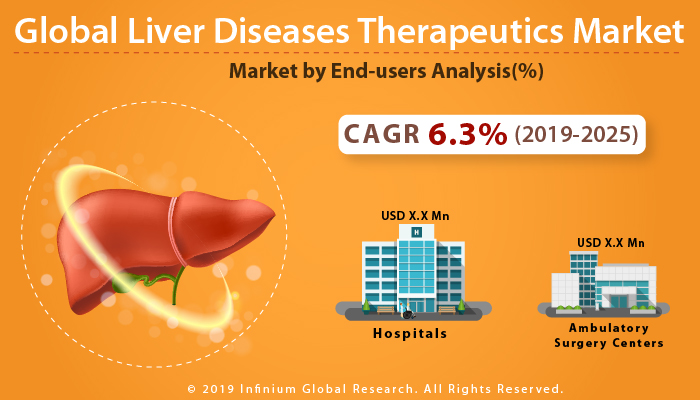Liver Diseases Therapeutics Market (Treatment Type - Anti Viral Drugs, Targeted Therapy, Immunosuppressant Drugs, Chemotherapy Drugs, Immunoglobulin, Corticosteroids, and Others; End-users - Hospitals, and Ambulatory Surgery Centers): Global Industry Analysis, Trends, Size, Share and Forecasts to 2025
A recent report published by Infinium Global Research on liver
diseases therapeutics market provides an in-depth analysis of segments and
sub-segments in the global as well as regional liver diseases therapeutics
market. The study also highlights the impact of drivers, restraints, and macro
indicators on the global and regional liver diseases therapeutics market over
the short term as well as long term. The report is a comprehensive presentation
of trends, forecast and dollar values of global liver diseases therapeutics
market. According to the report, the global liver diseases therapeutics market
is projected to grow at a CAGR of 6.3% over the forecast period of 2019-2025.
Market Insight
Globally, more than fifty million people are affected by liver
diseases. Seeking treatment as soon as possible is critical when it comes to
several liver diseases. Several common liver diseases can cause the organ to
become inflamed. This inflammation can progress to scarring or cirrhosis.
Therefore, the global market for the liver disease therapeutics market is
expected to grow at a success rate over the upcoming years.
The rising prevalence of liver fibrosis and liver diseases drives
the growth of the liver disease therapeutics market. The global prevalence of
cirrhosis from autopsy studies ranges from 4.5% to 9.5% of the general
population. Furthermore, the shifting lifestyle trends such as unhealthy diet,
physical inactivity, cigarette smoking, and harmful use of alcohol are the
major factors responsible for the increasing occurrences of several liver
diseases. In addition, an increased risk of liver damage among the growing
obese population also supports the growth of the market. Besides that, the
growing number of pipeline drugs for liver diseases boosts the growth of the
liver diseases therapeutics market. However, the high cost of treatment of
liver diseases restricts the growth of the liver disease therapeutics market.
Moreover, the increasing number of clinical trials to innovate new drugs create
numerous growth opportunities for the liver diseases therapeutics market.
Geographically, North America holds the maximum market share in
the liver diseases therapeutics market and is expected to remain the dominant
region over the forecast period owing to the rise in liver diseases in the U.S.
and Canada. In the U.S., 4.5 million people are affected by liver diseases. The
unhealthy eating habits of Americans also increase the risk of liver diseases,
thereby providing growth opportunities for the liver diseases therapeutics
market players. Moreover, Asia Pacific regions are also to gain a rapid
development in the liver diseases therapeutics market owing to the changing
lifestyle, increasing consumption of alcohol and cigarette smoking in Asian
countries such as India, Japan, Thailand, and several others.
Segment Covered
The report on global liver diseases therapeutics market covers
segments such as treatment type, and end-users. On the basis of treatment type,
the sub-markets include anti viral drugs, targeted therapy, immunosuppressant
drugs, chemotherapy drugs, immunoglobulin, corticosteroids, and others. On the
basis of end-users, the sub-markets include hospitals, and ambulatory surgery
centers.

Companies Profiled:
The report provides profiles of the companies in the market such
as Gilead Science Inc., Bayer AG, AstraZeneca plc, Merck & Co. Inc.,
GlaxoSmithKline plc, Sanofi, Pfizer Inc., F. Hoffmann-La Roche AG, Novartis AG,
and Johnson & Johnson Private Limited.
Report Highlights:
The report provides deep insights into the demand forecasts, market trends, and micro and macro indicators. In addition, this report provides insights into the factors that are driving and restraining the growth in this market. Moreover, The IGR-Growth Matrix analysis given in the report brings an insight into the investment areas that existing or new market players can consider. The report provides insights into the market using analytical tools such as Porter's five forces analysis and DRO analysis of liver diseases therapeutics market. Moreover, the study highlights current market trends and provides forecast from 2019-2025. We also have highlighted future trends in the market that will affect the demand during the forecast period. Moreover, the competitive analysis given in each regional market brings an insight into the market share of the leading players.
